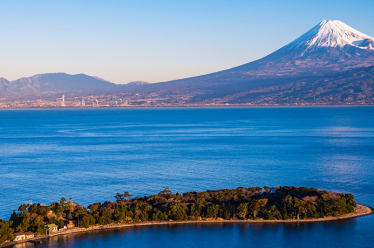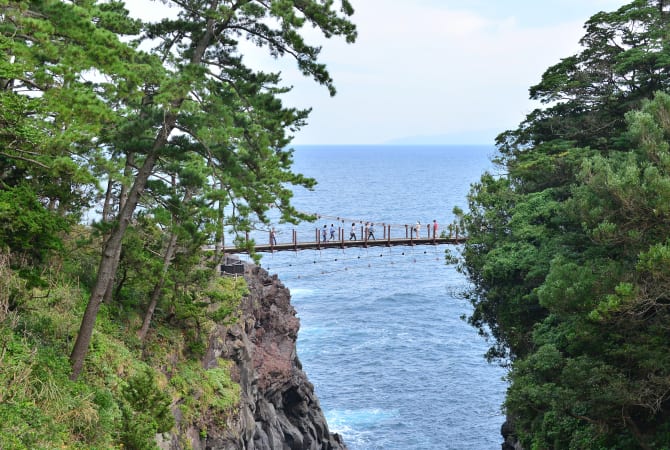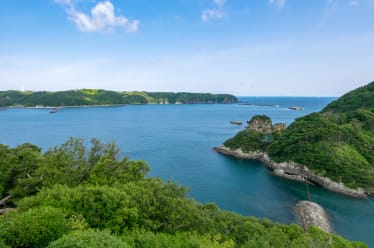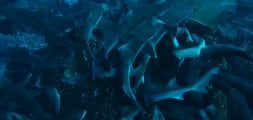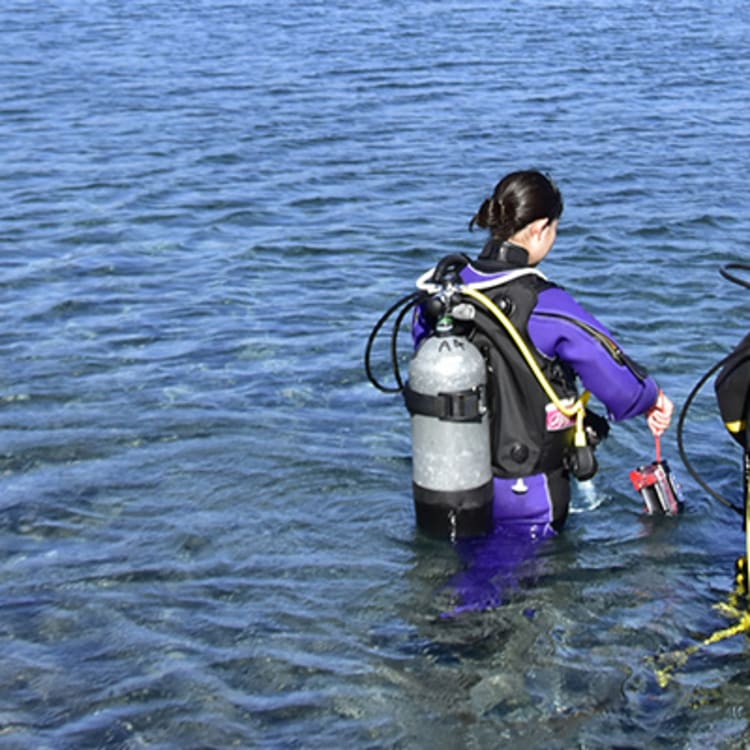
Shizuoka Diving Guide
The Izu Peninsula, situated between the nutrient-rich Sagaminada and Suruga Bay, the deepest in Japan, is where many divers from the Kanto region go to dive. There are more than 30 unique dive areas around the peninsula, each offering an amazing assortment of things to see, from macro creatures and schools of hammerhead sharks to beautiful cavern dive sites! The area is also popular with non-divers for its hot springs, beaches, and beautiful mountainous interiors. It is within day-trip distance from Tokyo, but if you plan on diving in the southern part of the peninsula, we recommend that you stay overnight.
What you can see
An amazing school of hammerhead sharks in Mikomoto.





Season Calendar for Divers
Eastern Izu
Northern dive sites of this area are easily accessible from Tokyo, and popular for day-trips.
IZUSAN
Izusan, the closest dive site to Tokyo in the Izu Peninsula, is known for having one of the oldest hot springs in Japan. Calm, shallow boat dive sites are great for beginner divers. You can enjoy arches and tunnels, and also the beautiful soft coral growing from them!

ATAMI
Atami is less than an hour from Tokyo by shinkansen and popular with both divers and non-divers. Atami is a great dive site for adventure lovers, offering wreck diving and cavern diving! One site boasts a huge shipwreck at the bottom of the ocean that is now a cozy home to many species of fish and covered with beautiful soft corals. Kosoga Cave, a cavern dive site, is open from November to March.

HATSUSHIMA
Hatsushima is a small island 25 min. from Atami by high-speed boat. It has four beach dive sites. Futatsune, on the east side of the island, is Hatsushima’s primary dive site. It is a great location to see schools of three-line grunt, yellowstriped butterfish, and greater amberjacks, as well as bullhead sharks and longtooth groupers hiding among the rocks and macro creatures such as jawfish and frogfish.

USAMI
There are both shore dive sites and beach dive sites at Usami, where you are almost 100% guaranteed to be able to see a bullhead shark, as well as the occasional stingray and sea turtle. A great dive site for beginners.

ITO
Ito is famous for its hot springs. There are many dynamic dive sites around Teishijima, an uninhabited island of Ito. Many pelagic fish such as Japanese amberjacks and greater amberjacks appear in schools during Autumn. At One-nokoshi, a boat dive site only open from September through May, you may see beautiful schools of scalefin fairy basslet and silver-stripe round herring creating a wall!

KAWANA
A popular dive site for sea turtles. Turtles are not rare in the Izu Peninsula, but there are not many dive sites located in their natural habitat. You can see them at Kawana Beach, a shore dive site, along with cute macro creatures such as frogfish and goby. You may even see lumpfish during winter!

FUTO
One of the most popular dive sites of Izu, great for both beginner and experienced divers. Yokobama, a shore dive site, is full of macro creatures such as frogfish and goby. Japanese angel shark and guitarfish also appear from time to time, and Futo Hole, a beautiful cave in Yokobama, is a must-see! Don’t miss the boat dive sites either!

IZU OCEANIC PARK
The first dive site in Japan. The complex seascape created by the explosion of now-extinct Mount Omuro has become home to many fish and other marine creatures. There are only shore dive sites in the area, but there are many different courses. At Ichinose, there is a chance you may get to see cute Sindo’s seahorses and frogfish. There is a long tooth grouper cleaning station at the sandy bottom.

YAWATANO
A popular dive site for underwater photograph enthusiasts located in the south of Jogasaki Beach. The most popular dive site is Yawatano Beach, rich in marine life. You can see frogfish, nudibranchs, lumpfish, and fringehead blenny here.

OKAWA
Here, no more than 50 divers are allowed to enter per day. Thanks to this rule, the marine ecosystem is well protected, and soft corals bloom everywhere. Huge bastard halibut, blotchy swellshark, and even sunfish can be seen here. Tropical fish carried by the Kuroshio Current from the warm waters of the south appear in Autumn.
HOKKAWA
A rare dive site with an underwater hot spring, Hokkawa boasts dynamic rock formations and colorful soft corals, tropical and pelagic fish, and a diverse population of macro creatures. Kajikaki is an excellent boat dive site to see schools of hundreds of yellow-striped butterfish and Japanese amberjack.
ATAGAWA
Atagawa is famous as a hot spring town with many fun places to go after diving, such as beautiful beaches and the Atagawa Tropical & Alligator Garden. There is a small arch and sandy bottom beyond it at shore dive site Takone, where you may see frogfish, nudibranchs, anemonefish, and, sometimes, spotted eagle ray.
INATORI
The long, beautiful white sand beach, a rarity in Japan, makes this dive site special. Sharks and stingrays such as banded houndsharks, bowmouth guitarfish, and spotted eagle rays can be seen here, as well as green sea turtles, beard grunt, and sea horses. The tidal pools offer an assortment of macro creatures for your viewing pleasure.
SHOBUZAWA
A dive site with a shipwreck, dynamic rock formations, sandy bottoms, and a forest of sea weeds, and an excellent location for both beginners and experienced divers to enjoy night diving all year long! Sea weeds and eelgrass thrive from spring to summer, and lumpfish come out in the winter.
Western Izu
You can enjoy the beautiful view of Mt. Fuji and amazing sunsets in Western Izu, farther from Tokyo, but easier to get to from West Japan.
KUMOMI
Kumomi is very popular for its unusual rock formations and cavern dive sites. The most popular dive site is Ushitsuki Iwa, with its tunnels, arches, and caves packed with schools of fish!

FUTO, DOGASHIMA
Nudibranch paradise! At Ukishima Beach, you may find almost 20 types of nudibranchs in just one dive! It is said that roughly 250 types of nudibranchs can be found here every year. Don’t miss the tornadoes of yellow-striped butterfish, which appear from summer to fall.

TAGO
Huge schools of scalefin fairy basslet, three-line grunt, yellow-striped butterfish, and greater amberjack dart between the bright, colorful soft corals that bloom everywhere at Futone. Dive deeper, and you may get to see a school of beautiful cherry anthias. Another noteworthy boat dive site is Tagojima, which is only open in the summer.

ARARI, KOGANEZAKI
Koganezaki Park Beach at the north of Arari port has excellent shore dive site and boat dive sites, and Koganezaki Beach is shallow and great for beginning shore divers. You may find cute macro creatures such as yellownose prawn-goby, frogfish, and goby hiding in discarded cans at the sandy bottom.

TOI
Toi has many facilities for divers, including a diving pool, and dive sites vary from calm southern sites that are great for beginners to northern dive sites recommended for well-experienced divers. Toorizaki is a fun shore dive site for both beginners and amateurs; many kinds of fish, sometimes even rare ones, appear. You can also explore a shipwreck at 25 meters below.

OSEZAKI
Probably the most popular dive site among divers in the Kanto region, excellent for both beginners and experienced divers. Wannai, the central dive site of the area, is calm almost all year long and rich in macro subjects. At its sandy bottom, you may find goby hiding in cans, frogfish, yellownose prawn-goby, and more! It is also famous for the occasional appearance of deep-sea fish such as the anglerfish during winter when the water temperature is low.

HIRASAWA
Compared to other dive sites in Izu, Hirasawa, open since 2014, is a relatively new dive site. The shore dive site is calm and comfortable all year long, and there are guide ropes underwater to make sure divers don’t get lost, as well as to help them remember the locations of the things they saw and come back on the next dive. Boat dives are also available! La La La Sun Beach, open to the public from July to August, is open to divers during other seasons.

ITA
Ita has only one dive site, but it is an excellent destination for photo enthusiasts. You can enter the water from any part of the 200-meter-long beach and take a different course for each dive. From summer to fall, you may see warty frogfish, schooling butterfish, and stocky anthias. During winter, you can watch beautiful nudibranchs in the crystal-clear water.
SHISHIHAMA
The dive sites in Shishihama are the closest sites to Tokyo in the Western Izu area. The shallow area is excellent for beginners, but keep on eye on the depth during your dive because the sites go as deep as 30 meters. Night diving is available all year long!
Southern Izu
The Southern part of the Izu Peninsula, sticking out into the Pacific Ocean, is directly hit by the Kuroshio Current, bringing the warm water of the ocean just above the Philippines to the area, along with many big fish such as hammerhead sharks and other pelagic fish. We recommend that you plan for an overnight stay.
SUZAKI
There are dive sites on both the east and west sides of the Suzaki Peninsula. Shore diving is common here, but boat dives are also available. From winter to spring, many lumpfish and nudibranchs can be seen at the shore dive site of Kujuppama, where you can take your time in the shallow waters observing fish and taking photos.

MIKOMOTO ISLAND
A very famous dive site for its schools of hammerhead sharks, sometimes reaching upwards of 100 sharks! Kamene is the boat dive site with the greatest chance of seeing hammerhead sharks, school of pelagic fish such as greater amberjack and Japanese amberjack, and other big fish. Green sea turtles are also a common sighting.

HAGACHIZAKI
Hagachizaki is known as the largest habitat for wild monkeys in East Japan; monkeys will greet you at the entry area of the only shore dive site of Hagachizaki. The most popular dive site is Benkei, an exciting boat dive site for intermediate divers where you may encounter greater amberjack and yellowtail amberjack, red stingray, green sea turtles, and even beautiful schools of scalefin fairy basslet!

NAKAGI
The southernmost dive site on the Izu Peninsula. Its beautiful coral reefs and transparency come from the Kuroshio Current’s effect on the area Hayama, a calm and shallow boat dive site, is perfect for beginner divers to see tropical fish and pelagic fish. You can also enjoy snorkeling at the beautiful Hirizo Beach.
How to get there
Located 100 to 150 km west from Tokyo, the Izu Peninsula belongs to the Shizuoka Prefecture. Thanks to the Shinkansen bullet train that goes to Atami in only 45 minutes, you can reach some of the most beautiful dive sites of mainland Japan from Tokyo on a day trip by train: Atami, Izu Ocean Park, and Atagawa.





























































